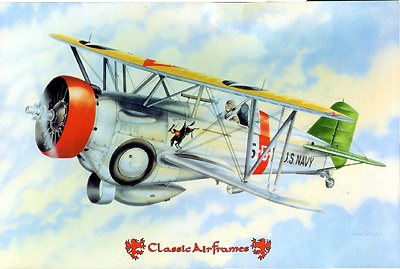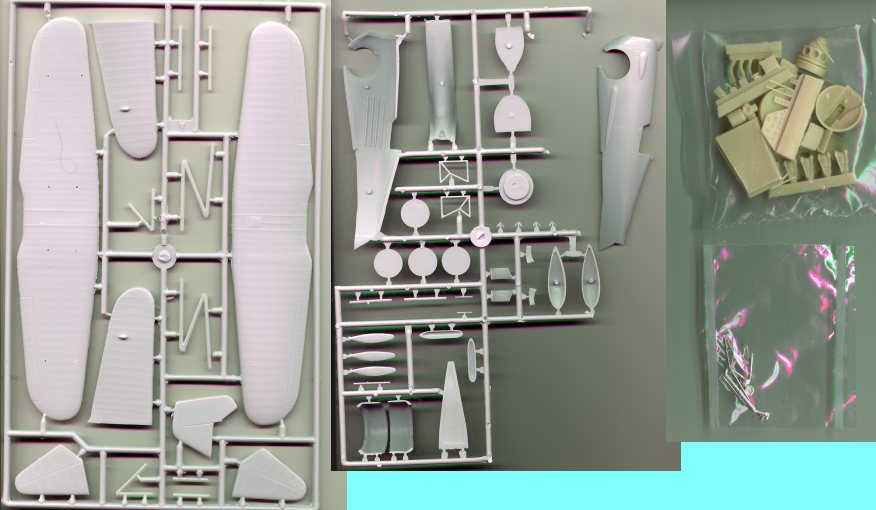
|
KIT: |
Classic Airframes 1/48 BF2C-1 |
|
KIT # |
433 |
|
PRICE: |
$29.95 |
|
DECALS: |
See review |
|
REVIEW & |
|
|
NOTES: |
|

|
HISTORY |
Between them, Curtiss and Boeing provided most of the fighters used by the U.S. Navy from the 1920s until the Grumman
F2F/F3F series appeared in 1935. The Curtiss "Hawk" series first began with the P-1 Hawk for the USAAC and the similar F6C-1 foor
the Navy; all subsequent aircraft shared similar wings and tail surfaces, with enging changes and landing gear changes between
the various models.
At the same time, Curtiss aggressively courted foreign customers, and became a major supplier of Hawks to South American
Air Forces and later to China and Thailand. Hawks IIs were used by Bolivia
against the Curtiss Falcons of Paraguay in the Chaco War, while in the far east,
China used both Hawk IIs and Hawk IIIs against the Japanese.
The final version of the Hawk biplane fighers for the US was the BF2C-1. The BF2C-1 was the least successful of the
line. Although it had an all-metal airframe and an uprated R-1820-04 engine, the natural
period of vibration of the new metal wing structure harmonized with the vibration of the engine, so that the airplane nearly
shook apart at cruising speed - they lasted in squadron service less than a year. The wooden-winged Hawk III did not suffer from
this problem, and was considered quite successful.
|
THE KIT |

I know this is the Hawk III sprues, but they are nearly
identical.- Ed
This kit is quite similar to the Hawk III kit. The main
differences being a two-bladed prop for the Navy fighter and a three-bladed prop for
the export version. In addition there were different engines and cowlings that
distinguished the two versions visually.
 The injection molded parts are light grey, coming on two sprues - one for wings and tail, one for fuselage, landing gear
and engine. This bodes well that an entire series will show up eventually. The F-11C-2 (Hawk II) and BFC-2 are already
scheduled for release in the next few months, and it is entirely possible that if sales justify it, we will see the Army Hawks -
The injection molded parts are light grey, coming on two sprues - one for wings and tail, one for fuselage, landing gear
and engine. This bodes well that an entire series will show up eventually. The F-11C-2 (Hawk II) and BFC-2 are already
scheduled for release in the next few months, and it is entirely possible that if sales justify it, we will see the Army Hawks -
the P-1 and P-6E. Engine wheel wells and cockpit detail parts are resin, and the retractable landing gear is made of white
metal. The decals are printed by MicroScale, and a very good full color markings and painting guide for
two aircraft provided
for in the decals. There are two vacuformed canopies in each kit.
 For once - finally!! - someone has gotten the wing shape right. The upper wing comes in two parts, while each lower wing
For once - finally!! - someone has gotten the wing shape right. The upper wing comes in two parts, while each lower wing
is one-piece of appropriate thinness, with the correct Clark "Y" airfoil section. The fabric effect is muted and realistic on
both wings and tail surfaces.
When I first checked these kits, I was certain for a moment that the tail color of the Navy Hawks was wrong, since VF-5B had
blue tails in their F3F-1s while aboard Ranger, changing to green tails when the markings and squadron designations were
rationalized in 1937. However, further research leads me to believe green is correct. For one thing, the photos of these
airplanes do not show the aircraft disignator and serial numbers in white, as they would be - and are for the F3F-1s - on a blue
tail. Additionally, it is stated in the book that the 1937 rationalization gave a particular tail color to the aircraft
carrier and all its squadrons as a group, rather than having the tail color assigned to individual squadrons. Since the BF2C-1
served in 1934-35, the colors would have been squadron-specific, and green appears correct.
Overall, I think this kit is one of the best kits yet released by Classic Airframes, and are a very welcome addition to
the ranks of Golden Age aircraft.
|
REFERENCES |
Aircraft of the Chaco War: 1928-1935 by Hagedorn and
Sapienza
Curtiss Aircraft 1907-1947 by Peter M Bowers
If you would like your product reviewed fairly and quickly by a site that has over 800 visits a day, please contact me or see other details in the Note to Contributors.